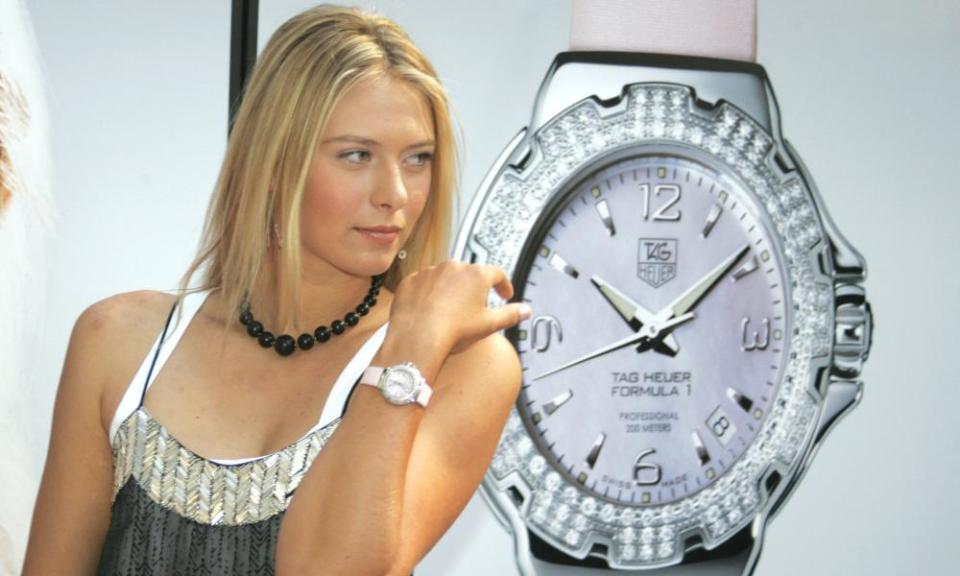Farewell Maria Sharapova: the ice queen who was more respected than loved
Fittingly, Maria Sharapova said goodbye to tennis on Wednesday in the pages of not one but two fashion magazines, a self-penned “essay” that allowed no scrutiny but invited a mixture of awe and sympathy.
The 32-year-old Russian, who won five grand slams and could freeze a room with her aloof grandeur, will be remembered as the ice queen of the sport, respected more than loved inside the game. She nonetheless was a media darling from the moment she beat Serena Williams to win Wimbledon when only 17 until the fading days of her career when meaningful victories for the world No 373 were distant memories.
It is a testament to her extraordinary clout that she invariably was given centre stage in big tournaments even though her best days were long gone. Sharapova, who won 36 titles and earned $38.7m in a career blighted by injury, never challenged Williams for dominance, although she fought for every point in a fruitless rivalry in which the American won 20 of their 22 matches.
Related: 'I'm saying goodbye': Maria Sharapova announces tennis retirement
The finish line was rushing at her over the past couple of seasons, and it was little surprise when the world No 19, Donna Vekic, bundled her out of the Australian Open in the first round in January. Sharapova went out in the first round of last year’s US Open, as well, to Williams, winning only two games.
There had been a smattering of wins over the previous 12 months, mostly against lowly ranked players. Her last win of significance was over the former world No 1 Caroline Wozniacki in the third round of the Australian Open last year but she was struggling with a career-long shoulder problem and the pointlessness of the exercise engulfed her in the end.
Younger stars such as the world No 1, Ashleigh Barty, the rising Belarusian Aryna Sabalenka and her compatriot Daria Kasatkina are too strong for her now. Yet she showed no sign of meek surrender, even when soundly beaten.
And, in a sometimes touching farewell piece, published simultaneously in Vogue and Vanity Fair, she revealed more of herself than she had done before – even in a self-serving autobiography and vetoed documentary that came out after she failed a drugs test in 2016.
“My edge,” she wrote, “was never about feeling superior to other players. It was about feeling like I was on the verge of falling off a cliff, which is why I constantly returned to the court to figure out how to keep climbing.”
She reckoned the US Open was the place where she could “overcome distractions and expectations”; her trips to Melbourne “took me to a place that had never been a part of me before – to an extreme confidence that some people call being ‘in the zone’. I really can’t explain it but it was a good place to be.”

Every night, perhaps, except the one four years ago when she lost to Williams in the quarter-finals (as she had done in the previous year’s title-decider) – and subsequently learned her long-term use of the banned drug meldonium would see her suspended from the sport for two years, later reduced on appeal to 15 months.
It was a crushing blow to her self-esteem and her image but she tried valiantly to stage-manage the penalty, pre-empting the announcement by the International Tennis Federation with a choreographed announcement in a Los Angeles hotel.
It was inevitable Sharapova would not leave her career in tatters in front of the cameras in that squalid setting and she tried valiantly to insinuate herself back into the big picture without ever convincing either her critics or her rivals that she could rediscover even slivers of her old magic.
It had all started so wonderfully for the blonde Russian who had invaded the United States with her stern and determined father, Yuri, in 1994, without means or command of the language, and convinced the IMG machine she was worth their attention. It was a career-long and fruitful partnership.
Sharapova hit No 1 in the world rankings five times, a considerable achievement in an era that sparkled with quality players. For 11 years in a row, Forbes magazine rated her the highest-earning female athlete in the world. Sharapova, whose father had $700 in his pocket when they arrived in Florida, knew all about earning money – and still does.
Related: Maria Sharapova: her career in pictures
Her choice of magazines to announce her retirement was entirely predictable. She has always been a fashion icon and still has the allure of a glamorous Hollywood celebrity.
Among her many interesting musings on Wednesday was an existential proposition about the purpose of it all. “Throughout my career, Is it worth it? was never the question. In the end, it always was. My mental fortitude has always been my strongest weapon. Even if my opponent was physically stronger, more confident – even if just plain better – I could and did persevere.”
She added: “In giving my life to tennis, tennis gave me a life. I’ll miss it every day. I’ll miss the training and my daily routine: waking up at dawn, lacing my left shoe before my right, and closing the court’s gate before I hit my first ball of the day.”
It has been one of the longest goodbyes in sport, one others identified way before Sharapova succumbed to the inevitable degradation in competitiveness. But no one could take away from her the indomitable spirit that compensated for any lack of flair.
If she sometimes looked better than she was, it was the most artful disguise. She will be missed for the one quality she had in abundance: bloodymindedness.

 Yahoo Sport
Yahoo Sport 



































































